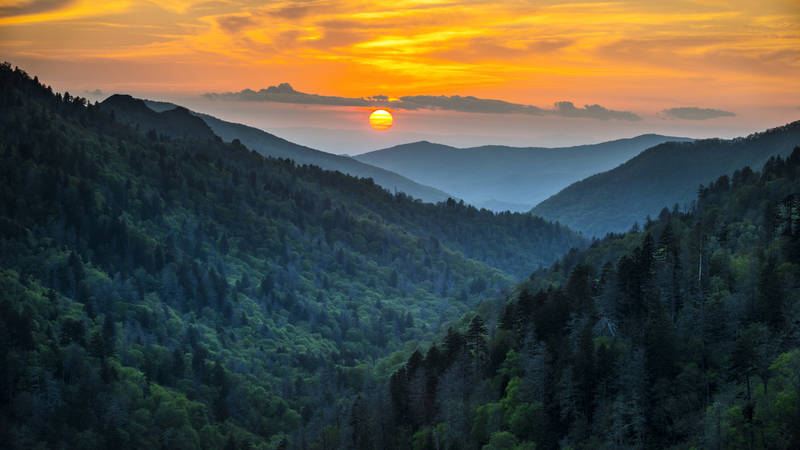Rolling back clean air protections would be bad for human health and the environment.
Last month, U.S. Environmental Protection Agency (EPA) acting Administrator Andrew Wheeler issued a memorandum (PDF) laying out his plans for the Regional Haze Rule, a program under the Clean Air Act meant to restore clean air to national parks and wilderness areas by developing state plans to address pollution across the country. Wheeler’s “Regional Haze Reform Roadmap” is not a binding document, but rather a blueprint outlining EPA’s vision for the program as states get ready to submit their plans to address air pollution, which are due in 2021.

Polluted Parks: How Dirty Air is Harming America’s National Parks
“Polluted Parks” graded the pollution-related damage in the 48 national parks required by the Clean Air Act to have the highest possible air quality.
See more ›Though the memo is short on substance, the language is telling. If this administration’s recent actions are any indication of what is to come, this roadmap could signal new ways that the EPA is looking to dismantle environmental safeguards designed to reduce air pollution and protect the air we breathe. This would directly harm public health, national parks and wilderness areas.
People care about park air quality. When pollution is high, park visitation drops by at least 8 percent. Across the nation, over 100 national parks suffer from levels of pollution that exceed public health standards. Degraded air quality limits park views by an average of 50 miles. The polluters causing these problems are also driving climate change, which is impacting national parks at twice the rate as the rest of the country. While we expect national parks to have clean air, they suffer from air pollution as much as the most polluted cities in the country. We have laws to help address these problems, but they only work if we use them for that aim.
The Clean Air Act’s Regional Haze Rule is a time-tested, effective program that protects national parks and public lands from air pollution. It has resulted in measurable, noticeable improvements in national park visibility and air quality, which in turn benefit the health of visitors and park ecosystems. Yet even as progress continues toward natural air quality at parks, the administration’s plans could sacrifice clean air in favor of polluter interests.
Here are five key points in Wheeler’s memo and what each could mean for the future of our health and public lands. The full memo can be found on the EPA’s website (PDF).
1. The State of Progress
Wheeler’s claim: “Current data shows that we have achieved considerable visibility improvement in affected areas throughout the country due to state efforts during the first planning period of the regional haze program, as well as emission reduction achieved under CAA [the Clean Air Act] program.”
It’s true that there have been considerable air quality improvements due in significant part to the Regional Haze Rule. But Wheeler is crediting these improvements to state efforts alone rather than acknowledging EPA’s fundamental role in enforcing states’ plans to reduce pollution. Many states have done tremendous work reining in polluters, but others such as Arizona and Oklahoma have fallen short of meeting clean air standards for decades. To improve air quality on public lands such as Grand Canyon National Park and the Wichita Mountains Wildlife Refuge, the EPA had to step in and require coal plant cleanup, leading to the closure of some of the most heavily polluting facilities. The administration simply can’t become a rubber stamp for state plans, or further progress will be in jeopardy.
2. Do As We Say, Not As We Do
Wheeler’s claim: “Through this memorandum, I am laying out a path for the EPA, led by the Office of Air and Radiation to take certain action to ensure that the agency provides adequate support to states to enable timely and effective implementation of the regional haze program today and in the future.”

EPA’s Proposed Texas Haze Plan Will Keep Air Across Our National Parks Hazy
Proposed EPA Haze Plan fails to require modern pollution controls on Texas Coal plants
See more ›It’s disingenuous that Wheeler is saying the EPA will enable states to implement the regional haze program in a “timely and effective” way at a time when the agency is rolling back several existing state plans to reduce pollution — undoing the very concept the agency is claiming to support. The EPA has already taken steps to roll back emission reduction plans in Utah and Arkansas where air quality for places such as Zion and Arches National Parks and the Buffalo National River are on the line. The EPA is also reversing a proposal that would have reduced 194,000 tons of sulfur dioxide pollution a year from Texas coal plants and could instead allow pollution to increase in the state, threatening places such as Big Bend and Guadalupe Mountains National Parks. This is alarming not only for the air quality in these states, but also for other plans across the country.
3. Less Is Not More
Wheeler’s claim: “During the next year, OAR [the Office of Air and Radiation] will release a series of implementation tools and guidance documents that will help focus states’ efforts and reduce and streamline the time and resources needed to meet the statutory and regulatory requirements for regional haze.”

Clean Power Plan Replacement Rule Weakens Climate Protections Allowing for More Air Pollution in National Parks
This replacement rule prioritizes interests of polluters over the future of our public lands and public health.
See more ›For this EPA, “streamlining” has meant fewer public hearings, shorter comment periods and the overall prioritizing of the fossil fuel industry’s interests over human health and our environment. If actions taken to further the Regional Haze roadmap follow the same pattern as other recent regulatory rollbacks on climate change, science and public health safeguards, the agency will needlessly threaten park waters, wildlife and landscapes and forever change how people experience these places. This reality of what this EPA means by “streamlining” runs counter to EPA’s mission to protect public health and the environment.
4. Passing the Buck
Wheeler’s claim: “In Spring/Summer 2019 – Update 2028 visibility modeling platform, documentation and results, including United States and international source contributions for Class I areas. These results can be used to inform the second planning period SIPs [state implementation plans] … to fully account for international impacts.”
International pollution is already accounted for when states develop their haze plans, and states are held responsible only for the emissions actually within their control. A new approach amplifying the role of international pollution would place undue emphasis on cross-border pollution that states cannot control, and could be used to excuse continued emissions from U.S. polluters that states can control. Passing the buck and shifting blame to other countries to release U.S. polluters from accountability is an unacceptable loophole that would result in dirtier air in our national parks.
5. The More You Know?
Wheeler’s claim: “The agency announced earlier this year that it would be revisiting certain aspects of the EPA’s January 2017 Regional Haze Rule. In that announcement, we specified that the EPA intended to address the Reasonably Attributable Visibility Impairment provisions, the provisions regarding Federal Land Manager consultation and possibly other elements of the rule.”
As part of the Regional Haze Rule, states are required to consult with federal land managers at the National Park Service, the U.S. Forest Service and the U.S. Fish and Wildlife Service when they develop their plans to reduce pollution, since these federal staff are the environmental stewards who know the parks, wilderness areas and wildlife refuges the best. As part of the Reasonably Attributable Visibility Impairment provisions Wheeler mentions here (known as RAVI), the National Park Service can, for example, compel a state to investigate a specific polluter and do an analysis to determine whether it is causing harm to a national park site and ways to mitigate that harm.
Stay On Top of News
Our email newsletter shares the latest on parks.
In January 2017, Obama-era revisions went into effect that required federal land managers to be better integrated into the regional haze planning process, specifying that states must consult with them earlier, and that they must talk with states before certifying any polluting source as problematic. These changes do not remove authority from states; rather they enhance the role of those who know the parks best. That Wheeler is singling out these RAVI provisions and the 2017 updates is extremely concerning, because it suggests the EPA could downgrade the role of the expert managers tasked with protecting our public lands. To undermine the expertise of these highly trained professionals would remove an important layer of protection from our national parks and public lands that would favor industry in the name of expediency.
At this point, we can’t know for sure how this memo will set the stage for air quality regulation across the country. NPCA will continue to evaluate EPA’s regional haze guidance, technical tools and rule changes to assess how the administration’s approach could impact people and national parks and what we can do to ensure our parks are protected. The Clean Air Act is an essential tool for clearing our skies and restoring health and visibility to our nation’s most iconic places, and we will continue to defend its principles and advocate for progress toward natural, healthy air.
About the author
-
 Stephanie Kodish Former Senior Director & Counsel, Clean Air & Climate
Stephanie Kodish Former Senior Director & Counsel, Clean Air & ClimateAs Senior Director and Counsel for Clean Air and Climate Programs Stephanie Kodish led NPCA's effort to drive solutions towards a healthy climate and clean air for national parks and communities.
-
Issues


